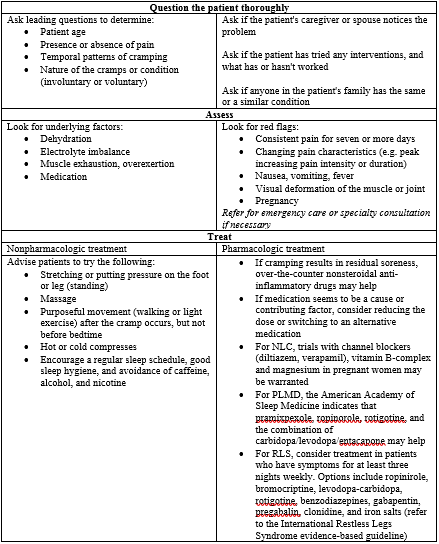Muscle Cramps: Alleviating the Aches and Pains
Whatever the patient calls them—growing pains, Charley horses, or night cramps—cramps are extremely common, especially in the legs and feet.
Whatever the patient calls them—growing pains, Charley horses, or night cramps—cramps are extremely common, especially in the legs and feet. When patients present with complaints of cramping, retail health providers need to be able to differentiate between various types. Many patients indicate that once they have one cramp, it seems as though they experience additional spasms, rebound cramping, and residual muscle tightness or pain.
Most people experience muscle cramps from time to time. Recreational or professional athletes will attest to the fact that failure to stretch and muscle fatigue often causes cramping. And, as overexertion depletes the muscles oxygen supply, lactic acid and other metabolites accumulate and spasm follows. Another common cause is heat, dehydration, and electrolyte depletion. But there are numerous other cramping syndromes, and for most of them, research has no explanation as to why they occur. The table describes some of the more common cramping conditions.

Growing painsare a common cause of distressing nocturnal awakenings in children. It's unclear how often they occur, but they seem to begin no earlier than age 3, the median occurrence at about age 8 to 9. They decrease in frequency as children age, and contrary to popular belief, are not associated with periods of peak growth. Growing pains may be related to overactivity during the day, low vitamin D levels or low bone density, anxiety, and low pain thresholds. These are all hypotheses, none of which has been proven.
Night leg cramps(NLC) affect approximately one-third of the general population. Although the word "night" is a part of this condition's name, patients report that about 27% of these cramps occur during the day making them an around-the-clock experience. NLC are more likely to occur in elderly patients, with roughly half of patients aged 64 or older reporting these cramps. NLC are not only painful, but also disturb the patient's sleep.
Periodic limb movement disorder (PLMD)occurs in 4% to 11% of adults, many of whom have restless legs syndrome (discussed below but also occurs as an isolated condition). Clinicians can diagnose PLMD after patients report 15 or more periodic leg movements per hour that usually occur at night. When the movements occur, patients may awake partially or fully, but it's likely that the patient's bed partner will find the movement more disturbing than the affected patient. Patients who have PLMD frequently report insomnia and/or excessive daytime sleepiness.
Restless legs syndrome(RLS) manifests while awake as a voluntary motor response to an uncomfortable feeling in the legs. Approximately 85% of RLS patients also have PLMD. However the opposite is not true: many people who have PLMD do not have RLS. PLMD is involuntary, and the patient may be unaware of these movements altogether. Patients with RLS complain of excessive daytime sleepiness (EDS), falling asleep during the day, trouble falling asleep at night, and difficulty staying asleep throughout the night. Sleep deprivation may tamper with emotional well-being (e.g., depression), lack of day time function, and social function.
Stepwise Treatment
Treating any cramping disorder depends on a good assessment. The figure gives a basic algorithm for retail healthcare practitioners.
In 2014, the approved the first device (Relaxis) for improvement of sleep quality in patients with primary RLS. It is a vibrating pad that delivers vibratory counterstimulation to the patient’s legs when they are recumbent in bed.
And a final note: in the past, clinicians have used quinine to treat nocturnal leg cramps. The FDA advises clinicians to avoid quinine for these indications because of the potential for severe adverse reactions.  
References
American College of Sports Medicine. ACSM’s Guidelines for Exercising and Prescription. 6th Edition. Philadelphia: Lippincott Williams and Wilkins is; 2014;62-73
Aurora RN, Kristo DA, Bista SR, et al; American Academy of Sleep Medicine. The treatment of restless legs syndrome and periodic limb movement disorder in adults--an update for 2012: practice parameters with an evidence-based systematic review and meta-analyses: an American Academy of Sleep Medicine Clinical Practice Guideline. Sleep. 2012;35(8):1039-62.
Food and Drug Administration. Serious risks associated with using quinine to prevent or treat nocturnal leg cramps. FDA News for Health professionals. 2012. Available at https://www.fda.gov/downloads/ForHealthProfessionals/LearningActivities/UCM317816.pdf. Accessed June 9, 2017.
Jeffrey S. FDA okays first device for restless leg syndrome. Medscape Med News. May 30, 2014. Krueger BR. Restless legs syndrome and periodic movements of sleep. Mayo Clin Proc. 1990;65(7):999-1006.
Lehman PJ, Carl RL. Growing Pains. Sports Health. 2017;9(2):132-138.
Monderer RS, Wu WP, Thorpy MJ. Nocturnal leg cramps. Curr Neurol Neurosci Rep. 2010;10(1):53-59. doi:10.1007/s11910-009-0079-5.















